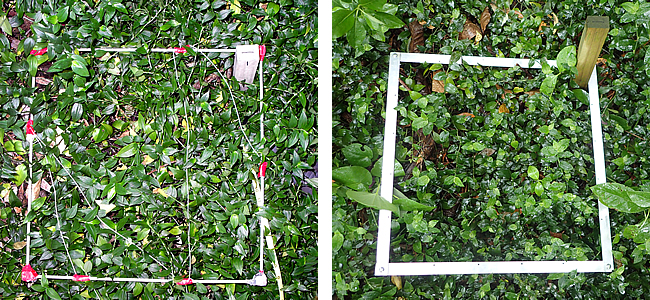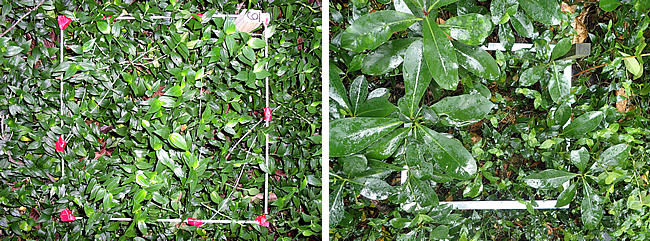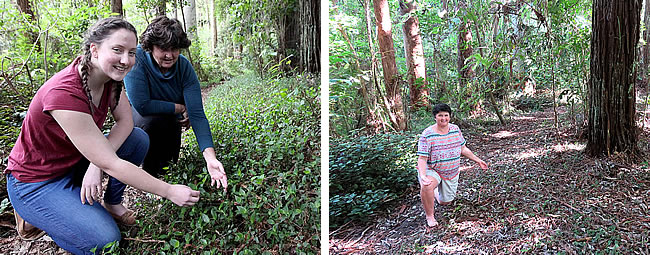Tradescantia be gone!
Brazilian beetles, first released in 2011, haven’t wasted any time getting stuck into the swathes of tradescantia (Tradescantia fluminensis) that are infesting gardens, reserves and conservation land. Three beetle species have been released − a leaf beetle (Neolema ogloblini), a stem beetle (Lema basicostata), and a tip beetle (Neolema abbreviata) − which were selected to attack different parts of the plant.
This summer Sam Cranwell, a visiting student from the University of Birmingham, Chris Winks, and Quentin Paynter have been revisiting some of the monitoring plots that were established to check on the beetles’ progress. “A key purpose of the monitoring plots is to assess the impact the beetles are having on tradescantia biomass, but we are also interested in looking for evidence that native vegetation is starting to recover,” said Quentin, who is leading the assessment work. Most of the monitoring has focused on sites where the leaf and stem beetles were released, since fewer plots were set up by regional councils for the tip beetle.
Information about how the beetles are performing in different sites or regions will help to determine where releases of the yellow leaf spot fungus (Kordyana brasiliensis) might be most useful. The first release of this fungus was made in March in Rotorua, and releases have also been made in the Waikato, Wellington and Tauranga. This is significant because, like the beetles, it is the first time this fungus has been released as a biocontrol agent in any country. The fungus damages the epidermal layer of the leaf, causing it to turn yellow and shrivel up. “So if it establishes, the fungus should be quite obvious to the casual observer,” said plant pathologist Chantal Probst, who has been infecting tradescantia plants, ready for distribution. “In the longer term we will use the monitoring plots to determine how much of an impact the fungus is having in addition to the beetles and whether it is complementary in terms of coexisting with the beetles,” said Quentin. “We don’t anticipate any issues since the two coexist in their natural range in Brazil,” he said. “The leaf beetle has established at all of the monitoring sites in the upper North Island, but appears to have failed to establish at monitoring sites set up in the Manawatū−Wanganui and Wellington regions,” said Quentin. We know the leaf beetle can establish in these more southern localities, as it is doing well at a site in Palmerston North, so failure to establish at the southern monitoring sites might just be bad luck or indicate that getting establishment there is harder. The cooler climatic conditions further south will probably affect the number of generations produced per season, and if a population builds up more slowly, releases may be more susceptible to failure. “Hopefully it’s just a case of making bigger or multiple releases to ensure beetle establishment in cooler sites,” suggested Quentin. “Or perhaps redistributing the beetles from cooler sites where they are doing well, given they might have adapted to local conditions,” he added.

However, the good news is that the leaf beetle has established really well at the northern survey sites, with impressive results already. “At Mt Smart, in Auckland, tradescantia has now all but gone from some of the plots, and has been replaced by a variety of natives,” said Quentin. “Even in quadrats where the percentage cover of tradescantia is still quite high, the biomass has reduced considerably. For example, the percentage cover of the first quadrat surveyed at Mt Smart in sampling last February was 71%, versus 93% in the original (prebiocontrol) sampling done in 2011. However, the mean height of tradescantia recorded for this quadrat was much lower (13.4 cm versus 39.2 cm) than in the original sampling, and we calculated from these measurements that the tradescantia biomass has declined by 74%, from 510 g/m2 to 133 g/m2 in that plot,” Quentin said. Past research has indicated that tradescantia biomass needs to be reduced below 200 g/m2 to give native plants a chance to establish and emerge above the weed. “So even though the reduction in percentage cover looks quite modest, the tradescantia biomass should now be low enough to allow native plants to recover in that plot. It isstill relatively early days and we would expect the impacts of the beetle to become even more apparent over time,” said Quentin.

Similar impacts were seen at Whitford (Auckland), Kerikeri and Maungatapere (Northland), indicating that the leaf beetle has already succeeded in reducing tradescantia below the required threshold in these northern sites. “In some places, damage by the beetles had been so extensive that the posts marking the edge of the plots had been left ‘high and dry’, with no tradescantia remaining, and in other plots native plants were clearly taking over,” said Quentin.
The impact of the stem beetle has been monitored at sites in Northland, Auckland and the Bay of Plenty, and this species is also showing impressive biocontrol potential. “The damage is encouraging but somewhat patchy. In wetter sites the percentage cover is still quite high, perhaps because tradescantia stems severed by larval feeding are capable of re-establishing, but bare patches are appearing in drier areas because severed stems likely desiccate and die,” said Quentin.
“Longer-term monitoring is needed to see how well the beetles will do in various combinations, and also further south and in Jenny Dymock Kings Rd, Northland, in spring 2016 and again in January 2018. Leaf beetles were released here in March 2015 and stem beetles in December 2016. wetter areas. But if they don’t succeed in these locations, we think the yellow leaf spot fungus might be the answer, based on our observations of habitats where it was most common in Brazil,” Quentin added.
“Overall, the results suggest that there is good evidence that the beetles are already achieving the goal of reducing tradescantia biomass to below threshold levels, at least at release sites in the northern half of the North Island. So, once we get all four agents out there working together we are quietly confident of a successful outcome nationwide,” said Quentin.

The assessment trials are funded by the Ministry of Business, Innovation, and Employment as part of Manaaki Whenua − Landcare Research’s Beating Weeds programme. We acknowledge the assistance of Auckland Council, and the Northland, Horizons and Greater Wellington Regional Councils, with setting up and monitoring plots. Efforts to release the tradescantia yellow leaf spot fungus are funded by the National Biocontrol Collective.
CONTACT
Quentin Paynter – paynterq@landcareresearch.co.nz
